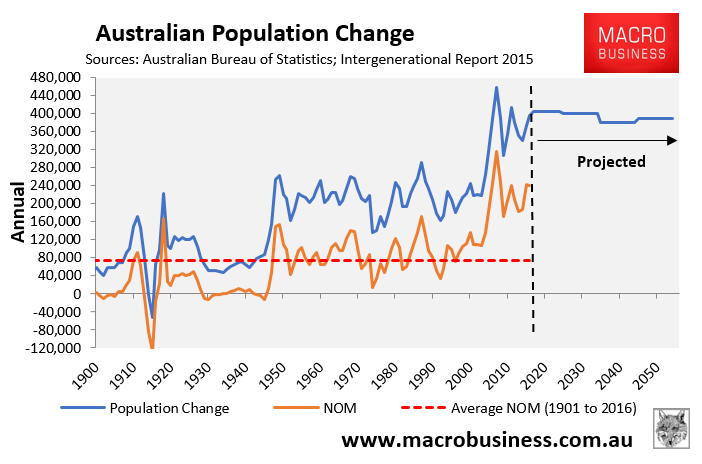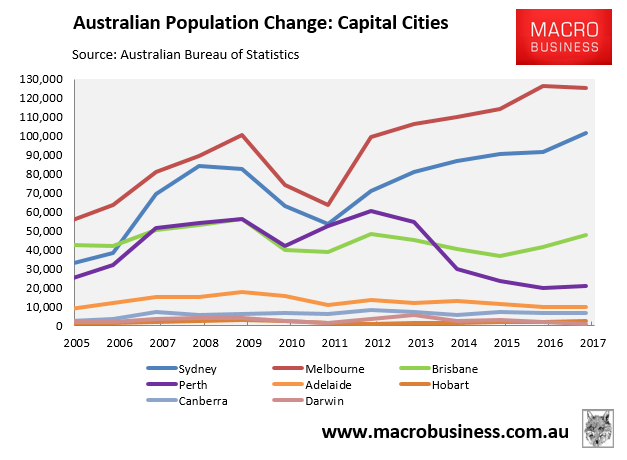Indigenous community leader, Warren Mundine, has thrown a barb at Australia’s major political parties and the Fake Left, calling for a sustainable and non-discriminatory immigration program. Here’s an extract from Mundine’s opinion piece in The Daily Telegraph:
To date the discussion among Australia’s political class has been muted with the major parties holding the line that current record immigration levels are both desirable and sustainable.
Regular Australians don’t see it the same way.
It’s not bigoted to debate whether Australia’s immigration levels should be reduced.
It’s a debate about how many immigrants Australia should take each year and about what population our cities and towns can realistically sustain…
By land mass, Australia is one of the largest countries in the world. But we also have one of the most concentrated populations.
Nearly half of all Australians live in three cities — Sydney, Melbourne and Brisbane. Include Perth and you have 55 per cent of the population…
It’s a key reason housing is so expensive and rental affordability is so low in major cities… Add to this that 90 per cent of new arrivals to Australia settle in Sydney or Melbourne. It’s no wonder both cities are bursting at the seams…
And here’s more from Mundine’s interview on Radio 2B:
“We’ve got to get away from calling people racist,” he tells Chris Smith.
“We’ve always had a non-discriminatory immigration policy since the 1960s.
“The issue is about numbers and the type of skills and professions they can bring to Australia to help build Australia.”
Too right. The fact of the matter is that Australia’s immigration intake is running at triple the historical average, after being ramped-up from the early-2000s:

This massive increase in Australia’s immigration (population) was never cleared by the Australian people and was done without proper planning and without consideration of longer-term consequences.
The end result has been Australia’s major cities – Sydney and Melbourne – taking the lion’s share of migrants and bursting at the seams from unprecedented population growth:

Enter new Prime Minister, Scott Morrison, who continues to sell the Coalition’s ‘migrants to the regions’ smokescreen:
Mr Morrison said there “could be a case” for tougher rules that slowed the intake of some temporary migrants into congested cities, but he warned against simplistic changes that would hurt areas that needed more workers.
In an exclusive interview with Fairfax Media, the Prime Minister likened his new approach to dealing with the huge variations in weather conditions across Australia.
“I’m happy to have a fair dinkum conversation about population, but we’re not going to do it in a vanilla sort of way, assuming that there is average population growth,” he said.
“There isn’t, any more than there is average rainfall. It was raining in Albury today, but it wasn’t raining in Quilpie”…
The government is working on a region-by-region approach to migration that puts a premium on migrants who go to parts of the country that need growth, including some capital cities as well as regional areas…
Mr Tudge has already aired the idea of encouraging migrants to settle in regional areas, but the government is yet to show how this can be done in a world where all permanent migrants are free to move where they wish.
However, big business front – the Migration Council of Australia (chaired by the Australian Industry Group’s CEO Innes Willox) – is already resisting sending migrants to the regions:
Carla Wilshire, from the Migration Council of Australia, says there are enormous benefits in regional resettlement for individuals and communities.
“However, it’s critical we have the necessary social infrastructure invested into these regional locations,” Ms Wilshire told AAP on Sunday.
“We also need to remember a lot of temporary workers that are settling in metropolitan areas are doing so because they have specific skills or qualifications that are vital to building the economy of the future.”
Ms Wilshire urged the prime minister to maintain a long-term view and consider the population size Australia needs to compete on a global scale.
Let’s be honest: Australia has tried decentralisation for more than a century without any success (other than the construction of Canberra).
Instead, the immigration program has become more centralised that ever, with 94% of migrants last financial year settling in the cities, and 86% settling in just Sydney and Melbourne alone.
Short of erecting ‘migrant proof fences’ and electronic angle bracelets, how can the federal government realistically force migrants to stay in the regions?
And how will these regions cope with significantly larger populations? The federal government is unlikely to fund the infrastructure and services necessary, thus will they end up similarly crush-loaded as Sydney and Melbourne, as well as suffering from a chronic shortage of water (since desalination is often not an option).
We also know that state-based migration programs have been systemically rorted, with migrants temporarily settling in places like the ACT and Tasmania purely to get the required number of points for permanent residency before moving to Sydney and Melbourne. How can this type of rorting of state and regional schemes realistically be stopped? It can’t.
This ‘migrants to the regions’ gimmick is merely another diversion from the major issue: that Australia’s immigration program is far too large – at roughly triple the historical average – in addition to being too concentrated into Sydney and Melbourne.
This ‘Big Australia’ policy has also lost the community’s support, with the five most recent opinion polls all showing majority support for lowering immigration:
- Australian Population Research Institute: 54% want lower immigration;
- Newspoll: 56% want lower immigration;
- Essential: 54% believe Australia’s population is growing too fast and 64% believe immigration is too high;
- Lowy: 54% of people think the total number of migrants coming to Australia each year is too high; and
- Newspoll: 74% of voters support the Turnbull government’s cut of more than 10% to the annual permanent migrant intake to 163,000 last financial year.
The Australian people want a genuine moderation of the migrant intake, not a poll-driven smokescreen. Cutting immigration is also Scott Morrison’s only hope of winning the upcoming election.

